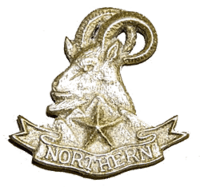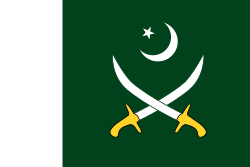Northern Light Infantry
The Northern Light Infantry (NLI) is a light infantry regiment in the Pakistan Army, based and currently headquartered in Gilgit, the capital of Gilgit–Baltistan. Along with other Pakistani military forces present in the Northern Areas (a part of Pakistan-administered Kashmir), the NLI has the primary responsibility of conducting ground operations in the interest of protecting the strategically important region of Pakistan. The regiment draws a majority of its recruits from native tribes present in the nearby mountainous areas and therefore they are less prone to altitude sickness and cold temperatures that characterize high-altitude mountain warfare, allowing the regiment to conduct its duties optimally.[2]
| Northern Light Infantry | |
|---|---|
 Regimental cap badge of the NLI. | |
| Active | 1975–present[1] |
| Country | |
| Branch | |
| Type | Light infantry |
| Role | Mountain warfare |
| Size | 16 battalions |
| Headquarters | Gilgit, Pakistan |
| Colours | Green, white, sky blue |
| Engagements | |
| Commanders | |
| Chief of Army Staff | |
| Colonel Commandant | |
The Northern Light Infantry is best known for the extensive assistance and training it provided to the Afghan Mujahideen (with backing from the CIA and ISI) during the Soviet-Afghan War.[3]
Formation
The Northern Light Infantry has its origins in the Gilgit Scouts raised by British India for defending the princely state of Jammu and Kashmir's northern frontier. The Gilgit Scouts, along with rebels in the Jammu and Kashmir State Forces, fought in the northern front of the Indo-Pakistani War of 1947-1948, conquering important points of interest such as Skardu, Kargil and Batalik (the latter two were captured by the Indian Army in subsequent operations). In 1949, the Gilgit Scouts were split into two forces, with the wing under the original name now designated for internal security operations. The second wing, named the Northern Scouts, were designated for major external operations. In 1964, the Northern Scouts were further bifurcated with the raising of the Karakoram Scouts based in Skardu. All three forces were brought together again in 1975, under the banner of the Northern Light Infantry (a Pakistani paramilitary force). Following the events of the Kargil War with India, the Northern Light Infantry was altered from a functioning paramilitary to a fully operational regular regiment of the Pakistan Army.[4][5][6]
A new paramilitary force was created in 2003 under the name Gilgit Baltistan Scouts to fill the role of the former Gilgit Scouts.[5]
Status and Operations
Originally the Northern Light Infantry was founded as a paramilitary force of Pakistan, at par with Pakistan Rangers and Frontier Corps, under the jurisdiction of the Ministry of Interior and commanded by regular Pakistan Army officers. In 1967 and 1970, two Battalions of the NLI were airlifted and deployed to Sindh and Karachi for internal security duties, riot control and aid of civil authority during election related violence. This earned them a commendation from Field Marshal Ayub Khan.
By 1998 the NLI consisted of 20 Battalions commanded by a Major General of the Pakistan Army with the designation of Inspector General of the NLI, whose office was the Inspectorate General of NLI reporting to the GOC, X Corps as well as the Minister of Interior.
Siachen Glacier
During the Siachen conflict the 1st Battalion NLI performed defense and support work.[2][7]
Kargil War
For the 1999 Kargil operation, it was reported that Pakistan army had launched forces exclusively from the Northern Light Infantry. These included 5, 6, 8 and 12 NLI battalions in full strength and elements of 3, 4, 7 and 11 NLI with the Chitral and Bajaur Scouts employed for logistic support.[2]
Since the Northern Light Infantry recruits are less prone to altitude sickness and cold temperatures, they were chosen to fight against Indian armed forces in Kargil war. Small infantry units belonging to Northern Light Infantry, slipped pass through Indian armed forces and seized strategic and important high points. Later, the infantry units used these strategic and important height points to launch attacks on Indian soldiers.[2]
After the Kargil War and in recognition of their outstanding performance in the Kargil conflict, the entire regiment was amalgamated into the Infantry Corps of the Pakistan Army with the status of a regular infantry regiment, awarded the Presidential Colours. Previously, the Northern Light Infantry regiment was a paramilitary force. After the Kargil war, it was promoted to regular army regiment.[2]
References
![]()
- This regiment was raised by British India in 1889 as the Gilgit Levies to operate in the princely state of Jammu and Kashmir, and since then it has undergone many changes. It continued to function as a Pakistani paramilitary force until 1999, when it was given the status of a regular regiment in the Pakistani military after the Kargil War.
- "Northern Light Infantry". Global Security. Retrieved 17 January 2018.
- Murphy, Eamon (2013), The Making of Terrorism in Pakistan: Historical and Social Roots of Extremism, Routledge, pp. 127–, ISBN 978-0-415-56526-4
- Northern Light Infantry Regiment (NLI) Archived 2018-03-25 at the Wayback Machine, Pakistan Army, retrieved 25 March 2018.
- History of Gilgit Baltistan Scouts, Gilgit Baltistan Scouts, retrieved 6 April 2018.
- Snedden, Christopher (2015), Understanding Kashmir and Kashmiris, Oxford University Press, p. 255, ISBN 978-1-84904-342-7
- "Northern Light Infantry". Pakistan Army Website. Archived from the original on 1 July 2018. Retrieved 20 June 2017.
Further reading
- "Northern Light Infantry". Globalsecurity.org. Archived from the original on 4 March 2016.

